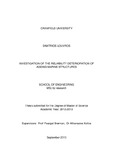JavaScript is disabled for your browser. Some features of this site may not work without it.
| dc.contributor.advisor | Brennan, Feargal | |
| dc.contributor.advisor | Kolios, Athanasios | |
| dc.contributor.author | Louvros, Dimitrios | |
| dc.date.accessioned | 2014-05-22T09:06:49Z | |
| dc.date.available | 2014-05-22T09:06:49Z | |
| dc.date.issued | 2013-09 | |
| dc.identifier.uri | http://dspace.lib.cranfield.ac.uk/handle/1826/8470 | |
| dc.description.abstract | In the present work, an investigation of the fatigue life benefits emerging from fillet weld geometries optimization has been carried out. At first, an introduction to ageing mechanisms, corrosion and especially fatigue, acting on operating marine structures has been made. Residual stresses at weld toes, stress modes, and types, geometrical factors (weld angle, toe radius, leg length), welding techniques selected, post-welding treatment and plate‟s material are some of the principal factors affecting the fatigue life of a fillet weld joint. Especially, the accuracy of various approaches in fatigue life estimation of specific geometries under pre-set types and levels of stress is studied. It is evident so far that even the notch stress concept is the most accurate method based on S-N curves, the Fracture Mechanics approach can offer more accurate solutions of a crack development through the material. Towards this, a literature review on crack evolution aspects in welded and non-welded plates under bending and tension was performed; substantial parameters were determined and finally implemented in the LEFM model which was used for the simulation purposes of Chapter 6. As far as the crack aspect ratio evolution is concerned, an extensive reference is available in literature since many researchers have investigated its contribution to the determination of geometrical paths, commonly known as “Preferred Propagation Paths”. Their significance is related with our ability to determine accurate SIF solutions leading to precise fatigue life estimations. A typical fillet weld joint 2-D model has been developed in CAE Abaqus software and a Finite Element Analysis of subject T-profile has been carried out. Through this analysis, the fillet weld angle, the weld leg length, the weld toe curvature radio ρ and the carrying load plate thickness are examined for their impacts on the maximum surface stress. Finally, a number of stress mitigating measures are proposed and their effects are analyzed. Undoubtedly, the notch stress concept today is gradually gaining more and more acceptance among other fatigue analysis practices, hence the need for an estimation of the actual surface stresses along fillet weld toes, has become imperative. Towards this, different 2-D geometries are tested against stress concentration factors developed at weld toes, which are calculated on the basis of maximum in-plane principal stresses over nominal stresses in mode I pure bending and pure tension respectively. Moreover, validation with corresponding results from literature is provided. Finally, three different concepts for reducing the maximum surface stresses are presented. The first one proposes grinding of the weld toe area and formulation of an artificial U-notch or a part- circular profile. The second one applies to non-penetrating welds and assumes the existence of a root gap of a specific geometry which is related to the fatigue life and stress concentration factor of the fillet weld joint. Last but not least, the relatively recent concept of the variable radius notch is discussed, even though it is applicable mostly to notched bodies, not weld joints. Afterwards, a Linear Elastic Fracture Mechanics analysis of reference 2D fillet weld model is demonstrated. A number of geometrical parameters considered at previous stage for their impact on surface Stress Concentration levels at the weld toe region, have been correlated to fatigue life benefits in terms of increased number of stress cycles till failure. An extensive analysis of 9 different T-butt weld joint geometries has been provided in order to investigate how positively a possible SCF reduction can affect the fatigue life of a weld joint. Essential geometric variations (weld angle, length, toe radius, root slot) were considered in the 2D model. All calculated benefits both in pure bending and pure tension cases have been reported accordingly. Based on a linear interpolation of the points scatter (SCF, N-cycles) both in banding and tension, it was observed that a surface stress mitigation of 1% could lead to 1,33 up to 2,5% fatigue life benefit in the range of SCF=2 – 2,5. It is evident so far that the geometrical optimization of a weld joint in respect of notch stress mitigation can be a powerful tool both in shipbuilding and maintenance practice in the future. However, technically wise their application may incur high initial costs of improved tools of welding and post welding treatment and robots even though it would consist a cost effective solution in a medium/long term basis. Finally, the above process is followed by a reliability analysis of the most critical geometrical parameters affecting the fatigue life of a fillet weld joint. Reliability assessment results concerning medium, high and low cycle fatigue are provided and a comparative analysis of each factor‟s impact on fatigue life has been carried out. | en_UK |
| dc.language.iso | en | en_UK |
| dc.publisher | Cranfield University | en_UK |
| dc.rights | © Cranfield University 2013. All rights reserved. No part of this publication may be reproduced without the written permission of the copyright owner. | en_UK |
| dc.subject | Linear Elastic Fracture Mechanics | en_UK |
| dc.subject | stress intensity factor | en_UK |
| dc.subject | structural reliability | en_UK |
| dc.subject | fillet weld joint | en_UK |
| dc.subject | fatigue life | en_UK |
| dc.title | Investigation of the reliability deterioration of ageing marine structures | en_UK |
| dc.type | Thesis or dissertation | en_UK |
| dc.type.qualificationlevel | Masters | en_UK |
| dc.type.qualificationname | MSc by Research | en_UK |
